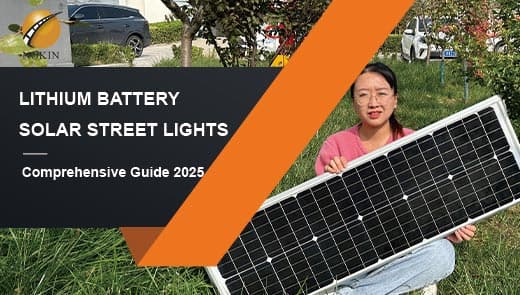2025 Solar Street Lights Market Price Analysis and Trends
Under the wave of global sustainable development, solar street lights have gradually become an important force in the field of lighting by virtue of their green and energy-saving advantages. In this article, we will analyze the factors that influence the market price of solar street lights in 2025, the current market price status, future development trends, and how to buy cost-effective solar street lights, which will serve as a reference for consumers, investors and industry participants.
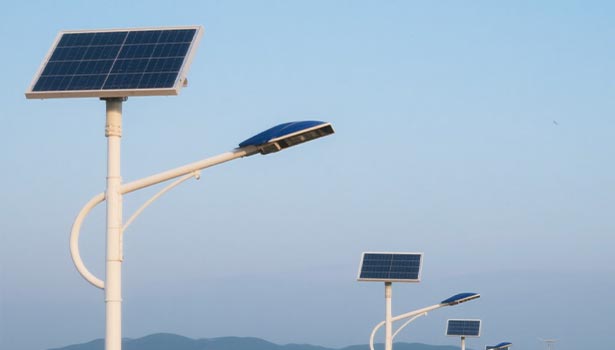
Several key factors that influence the market prices of solar street lights
Material costs
Solar panels are the core components of solar street lights, and their prices are significantly affected by type and efficiency. Monocrystalline panels have high efficiency, long lifespan, and higher initial cost, while polycrystalline panels are relatively affordable. For example, in areas with sufficient light, monocrystalline panels can better utilize the advantages of high energy conversion rates, which can result in cost savings in the long run, but the initial purchase cost may be 20% - 30% higher than that of polycrystalline panels.
|
Type of Solar Panel |
Initial Cost |
Energy Conversion Efficiency |
Lifespan |
|
Monocrystalline Silicon |
High |
18% - 24% |
25 - 30 years |
|
Polycrystalline Silicon |
Lower |
15% - 19% |
20 - 25 years |
With the advancement of manufacturing process, the cost of LED lamps and lanterns has dropped significantly, but the price of high-end products is still high. High luminous efficiency, long life LED lamps, its luminous efficiency up to 150 - 200 lumens / watt, compared with ordinary LED lamps 50% higher, the price is also 30% - 50% higher, but in the lighting effect and life expectancy advantages. The cost of different types of batteries varies greatly. Lithium iron phosphate (LiFePO4) and lithium ion batteries have superior performance, but the price is 2 - 3 times that of lead-acid batteries. Lead-acid batteries are less expensive, but have a shorter lifespan and more frequent maintenance; LiFePO4 batteries have a cycle life of 2000-3000 cycles, which is 3-5 times that of lead-acid batteries, making them more suitable for long-term use.
Technological progress
The application of Maximum Power Point Tracking (MPPT) controllers, Internet of Things (IoT) technology and smart sensors has improved the energy management level of solar led street lights. MPPT controllers can make solar panels always work at the maximum power point, improving power generation efficiency by 10% - 30%, but also increasing the initial cost of the product by 15% - 25%. 25%. Smart features such as adaptive lighting, fault detection and auto-cleaning increase the initial cost but reduce maintenance costs and improve energy efficiency. For example, adaptive lighting automatically adjusts brightness based on ambient light and foot traffic, reducing power consumption by 30% - 50%.
Market demand
As urbanization accelerates and countries focus on renewable energy, demand for solar street lights is surging. In some emerging markets, the annual growth rate of demand can reach 20% - 30%, and the price will rise accordingly when demand exceeds supply. Large-scale production can reduce costs. When the production scale is doubled, the unit product cost may be reduced by 10% - 20%, which makes the price of solar street light in the long term has a downward trend.
Policy support
Many countries and regions provide subsidies and tax incentives for solar street lights. For example, a certain region gives 30% financial subsidies to enterprises purchasing solar street lights, which greatly reduces their purchasing costs. Strict energy efficiency and sustainable development regulations encourage cities to prioritize solar street lights in construction. In some cities with high environmental requirements, the proportion of solar street lights in new road lighting projects has exceeded 70%.
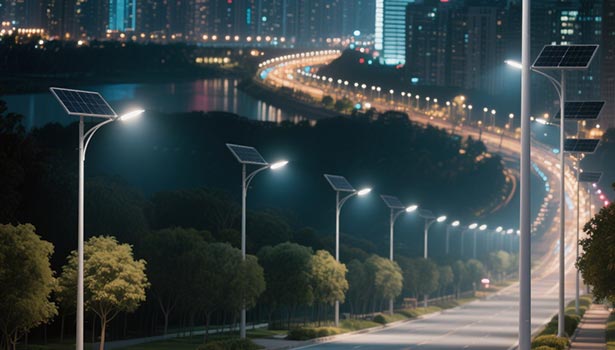
Market price analysis of solar street lights in 2025
2023 price range as reference
|
Product Type |
Price Range |
Application Scenarios |
Configuration Features |
|
Basic Solar Street Light |
$300 - $600 |
Rural roads, residential communities |
Low configuration, meets basic lighting needs |
|
High-End Smart Solar Street Light |
$1000 and above |
Urban main roads, commercial areas |
Features smart sensing, remote monitoring, etc. |
Reasons for current price differences
Higher-quality modules and better manufacturing processes boost product costs. For example, high-quality solar panels can generate electricity efficiently even in low-light environments, while the performance of low-quality panels will be greatly reduced. Well-known brands invest heavily in R&D, production and after-sales service, and consumers are willing to pay for their brand premium. Branded products can cost 20% - 30% more than generic products.
How to choose a cost-effective solar street light
Detailed configuration
Lamp power: It is crucial to choose the lamp power accurately according to the actual lighting demand. If the power is too large, it will cause energy waste and increase costs; if the power is too small, it will not meet the lighting requirements. Generally speaking, due to the relatively small amount of people and traffic in the countryside, 10 - 30 watts of lamp power can meet the basic lighting requirements; while the city's main roads are frequently traveled by people and vehicles, 50 - 100 watts of lamp power is needed to ensure adequate lighting.
Battery capacity: To ensure that the battery capacity to meet the night lighting hours and continuous rainy weather power needs. At the same time, be wary of products on the market that falsely label capacity. Can be based on the local sunshine hours, lamps and lanterns power and desired lighting hours, through the professional formula to calculate the required battery capacity. For example, the average daily sunshine hours in a certain area is 6 hours, the power of the lamps is 30 watts, and it is expected that the street lamps can work normally in 3 consecutive cloudy and rainy days and illuminate for 8 hours a day, and the required battery capacity is calculated to be about 120 ampere hours.
Solar panel size: the size of the solar panel is directly related to the power generation capacity, need to be combined with the local light conditions and the lamps and lanterns power demand reasonable choice. In areas with sufficient light, a smaller size of high-efficiency solar panels can be used; in areas with general light conditions, a larger size of panels is needed to ensure sufficient power generation.
Light pole material: common pole materials are steel, aluminum alloy and stainless steel. Steel light pole cost is relatively low, but in the outdoor environment is prone to rust, need regular maintenance; aluminum alloy light pole has the advantages of light weight, corrosion resistance, moderate price; stainless steel light pole is the most durable, corrosion-resistant performance is strong, but also the highest cost. In the choice, to consider the use of the environment and budget, such as the seaside and other corrosive environment, give priority to aluminum alloy or stainless steel poles; ordinary areas, if the budget is limited, you can choose the anticorrosion treatment of steel poles.
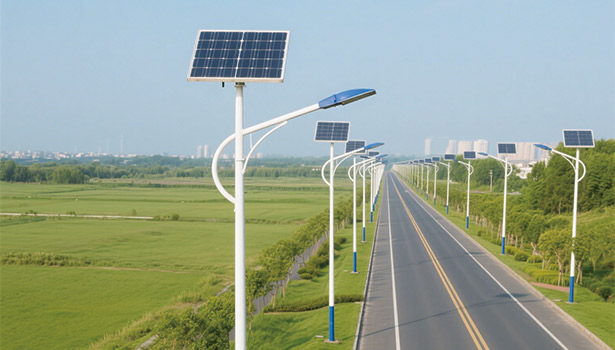
Road requirements
Road width and luminaire type: The width of the road is a key factor in deciding whether to choose single-arm or double-arm solar street lights. Usually, the width of the road is less than 6 meters, single-arm solar street light can meet the lighting needs of a single side, installation and cost is relatively low; road width is greater than 6 meters, in order to ensure that both sides of the road have a good lighting effect, you can consider the double-armed solar street light, but its cost will increase.
Light spacing and brightness: Determine the appropriate light spacing and brightness according to the function of the road. As a major traffic artery in the city, the brightness requirements are higher, the light spacing can be set to 25 - 35 meters to ensure the safe passage of vehicles and pedestrians; community roads mainly serve the residents in their daily travel, the brightness can be moderate, the light spacing can be appropriately increased to 30 - 40 meters, which can meet the lighting needs, but also reduce the cost.
Pole height and power/brightness: The height of the pole is closely related to the power and brightness of the required lamps. Generally speaking, the higher the pole, the wider the light coverage, but at the same time, a higher power luminaire is needed to ensure the brightness of the ground. For example, a 6 meter high pole with 30 - 50 watt lamps is suitable; an 8 meter high pole needs 50 - 80 watt lamps to achieve good lighting effect.
Warranty time
Generally speaking, the warranty time of solar street light ranges from 1 - 5 years. Longer warranty time usually means that the quality of the street light is more guaranteed and the manufacturer has more confidence in the product. Because during the warranty period, if the product has quality problems, the manufacturer is responsible for repair or replacement. However, the price of products with a long warranty is often relatively high. Consumers in the choice, to consider the price of the product, quality and their own expectations of the product life, weigh the length of the warranty and price, choose cost-effective products.
Brand
Check the brand's official website, industry forums, e-commerce platform evaluations and other channels through the Internet to gain an in-depth understanding of the brand's R&D capabilities, production scale, product quality certification and other aspects of strength. Check whether the brand has a professional R&D team, whether it has large-scale production capacity to ensure the supply of products, and whether it has obtained relevant international and domestic quality certificates, such as ISO quality management system certification, CE certification and so on.
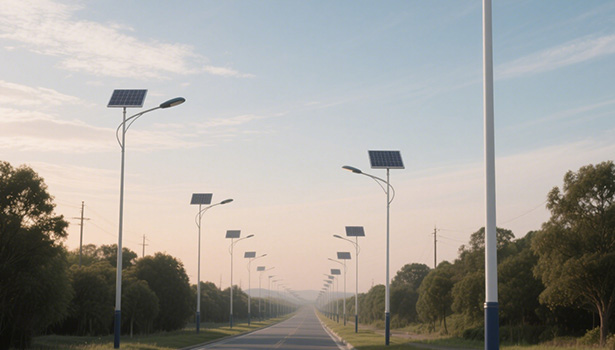
Future trends of solar street lights
Intelligent trend: integration with IoT and smart technologies
Application of High Efficiency Luminaires: Along with the continuous advancement of LED technology, solar street lights will adopt higher efficiency in the future. street lights will adopt more efficient LED luminaires, which will significantly improve the lighting effect and further reduce energy consumption. For example, the luminous efficacy of new LED luminaires is expected to increase from the current 150-200 lumens/watt to 250-300 lumens/watt, which means that under the same lighting demand, the lamps will require less power, which can greatly reduce energy consumption.
Intelligent control system upgrades: Future solar street lights will integrate remote monitoring, automatic brightness adjustment, fault warning and other functions, and can be closely linked with the city management system. For example, through the integration of photosensitive sensors and motion sensors, the street light can automatically and accurately adjust the brightness according to the ambient light and the flow of people. In the late night when there are few people, low light demand to reduce the brightness, reduce power consumption; in the pedestrian and vehicle when more brightness to protect traffic safety. This intelligent upgrade can provide more convenient and efficient data support for city management, realize accurate management of street lights and reduce operation costs.
Green and environmental protection: meeting growing demand for sustainable solutions
Improvement of Energy Utilization Efficiency: Under the background of rising global environmental protection awareness, energy saving and environmental protection have become the core trend in the development of solar street lights. Solar street lights convert solar energy into electricity through solar panels, realizing self-sufficiency of the lighting system and greatly reducing the dependence on traditional power grids. In the future, the application of high-efficiency solar panels will further improve the efficiency of energy utilization. For example, a new generation of solar panels photovoltaic conversion efficiency may be raised from the current 20% - 25% to 30% - 35%, so that the solar street lamps in the limited light conditions can collect more electricity.
Intelligent energy-saving lighting: Intelligent control system will automatically adjust the brightness according to weather, traffic conditions and other factors to achieve more energy-saving lighting effects. In cloudy or rainy days when the light is insufficient, the system automatically reduces the brightness to save electricity; in the road and time with heavy traffic flow, it ensures sufficient lighting brightness. At the same time, the solar street light will also be combined with other renewable energy generation systems to build a green urban lighting system, reduce carbon emissions and help environmental protection.
2025 solar led street light market price is affected by a variety of factors, showing different price ranges. In the future, with technological innovation, policy support and market development, solar street lights will develop in the direction of intelligence, greening and personalization. Consumers in the purchase, need to consider the configuration, road demand, warranty and brand and other factors, in order to select a cost-effective solar street light products, to promote the application and popularization of solar street lights in more scenes.

